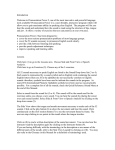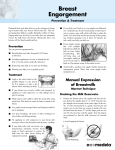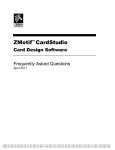Download Please note for this program: Words in English are
Transcript
Please note for this program: Words in English are often pronounced differently when said alone than when said in a sentence. Listen to the difference carefully. It is important to learn to hear the different pronunciations of words. Some words are not linked from the sentences to the dictionary because they have many uses and not all of the uses are covered in our dictionary. The following words are not linked: at, away, back, by, of, out, on, up, about, in, for, to, down, into, off, over, along, with, that, board, call, caught, clear, dash, few, fill, fine, flying, give, hang, high, last, late, leave, like, lost, material, old, one, only, patch, Penny, pick, photograph, play, pole, printed, punch, pupil, quarter, row, set, short, skip, smoke, sprouts, strong, take, there, time, turned, type, wedding and work. In the Sentences exercises the word "don't" is linked to the word "do" in the dictionary. Don't means do not. 1) Language Choice- The user can choose to change the language at any time 2) Help Bar-This area shows translated instructions for using the program. The instructions appear in this bar when the user places the cursor over a button or functional area. The user can also see a translation of a word here by placing the cursor over a word in a sentence from one of the linked exercises (The words in the following exercises -Sample Words, Comparative Words, Level 1 Sentences and Level 2 Sentences are linked to the dictionary.) 6) Go back to the previous page 7) Record/Stop 8) Play 9) Instructor 10) Cursor 12) Print 13) Exit 14) Lessons -Click here to go to the Lessons area. 15) Exercises -Click here to go to the Exercise section. Choose any of the 7 practice exercises. 16) Dictionary -Click here to go to the dictionary. 17) Games -Click here to go to the 4 available games. Choose a listening game to practice your listening skills. Choose a recording game to practice your speaking skills. Lessons Select a sound from the sound list (18). This sound will be the sound used for the exercises unless you choose a new sound. You can hear the sounds by placing the cursor over each sound symbol. Select Side & Front View or Speech Analysis by clicking on the drop down menu (19). The Side View shows the tongue and mouth movement necessary to make each of the 52 sounds. Click on the play button (20) to show the movement and hear the sound. Click continuously on the slow motion button (21) to see the movement frame by frame. The user can stop clicking to see points in the mouth where the tongue touches. A flow of air through the mouth is necessary to make sound. Legend for airflow and voice box: A Full -Air flow is not blocked. A Released - The air is stopped, then released. B Obstructed - Flow of air through a small space. The voice box is used to make some sounds. It vibrates if you are using it to make a sound. You can feel when you are using your voice box to make sound by placing your finger on the bottom of your throat. The side view shows you when to use your voice box to make a sound and when not to use your voice box. C Voice box is used D Voice box is not used The Front View shows the lip movement necessary to make the chosen sound. Click the play button (22) to show the movement. Speech Analysis is used as a visual aid for learning how to pronounce a sound correctly. The picture that you see is called a waveform. Click on the Instructor (9) button to hear the instructor's recording. Click on the Record button (7) to record your voice and then again to stop the recording. Click on the Play button (8) to hear your recording. Listen to the instructor and then record yourself saying the same sound. Compare your recording and your waveform to that of the instructor's. Remember that each person's voice is unique due to differences in intonation, volume and pitch. A waveform is therefore similar to a person's thumbprint in the sense that no two waveforms will ever be the same. This means that it is impossible for you to completely match the instructor's waveform. The key is to make your waveform match as closely as possible by fitting it into the shaded area on the screen. If your waveform is not aligned directly under the instructor's, move your mouse over top of your waveform (you will notice that the cursor (10) changes from an arrow to a hand) and then click and drag your waveform until it is aligned properly. Exercises Sample words - Choose this exercise to practice words that have the sound you have chosen. Listen to the instructor (9). Record yourself (7). Listen and compare yourself to the instructor (8). Click on the toggle button (23) to highlight the sound in the word that you are working on. Remember that there are many ways to spell some of the sounds in English. This toggle button will help you see the different ways of spelling the same sound. Click on the disc (24) to save your recording. Comparative words - Choose this exercise to practice words that have different but similar sounds. Listening Discrimination A - Choose this exercise to practice hearing different sounds in words. Listening Discrimination B - Choose this exercise to improve your listening skills. Test your ability to recognize a word in speech. Listen to the instructor (9) and choose which word he said by clicking on it. If you are correct a green check mark (25) will appear. If you are incorrect a red cross (26) will appear. Click on the instructor's recording of the two words (27) if you want to hear both words. S.T.A.I.R.-Choose this exercise to practice several speaking skills. S -Stress in words. Large dot shows strong stress. Small dot shows weak or no stress. T -Timing -Watch the highlights on the words move with the instructor's voice. Record your voice along with the moving highlights. A -Articulation -Words are often shortened when they are linked to other words. This is shown with a curved line above the words. I -Intonation and pitch. These voice changes are shown with arrows. R -Rhythm. Watch the highlights as with timing. Listen to each sentence and watch the moving highlights and the symbols. Record along with the highlights. Level 1 Sentences - Choose this exercise to practice listening and speaking. Level 2 Sentences - Choose this exercise to practice listening and speaking. These sentences are more difficult than the sentences in Level 1.










